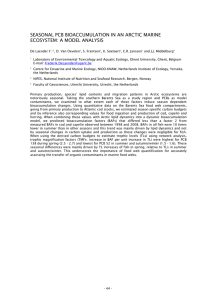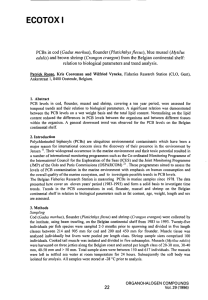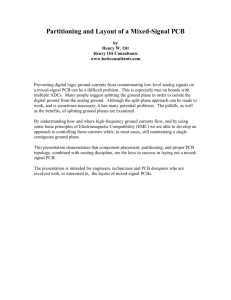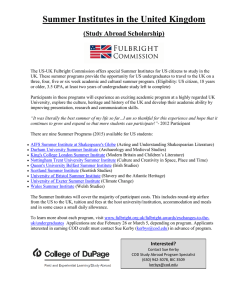flounder blue 4.1 PCBs in cod from the
advertisement
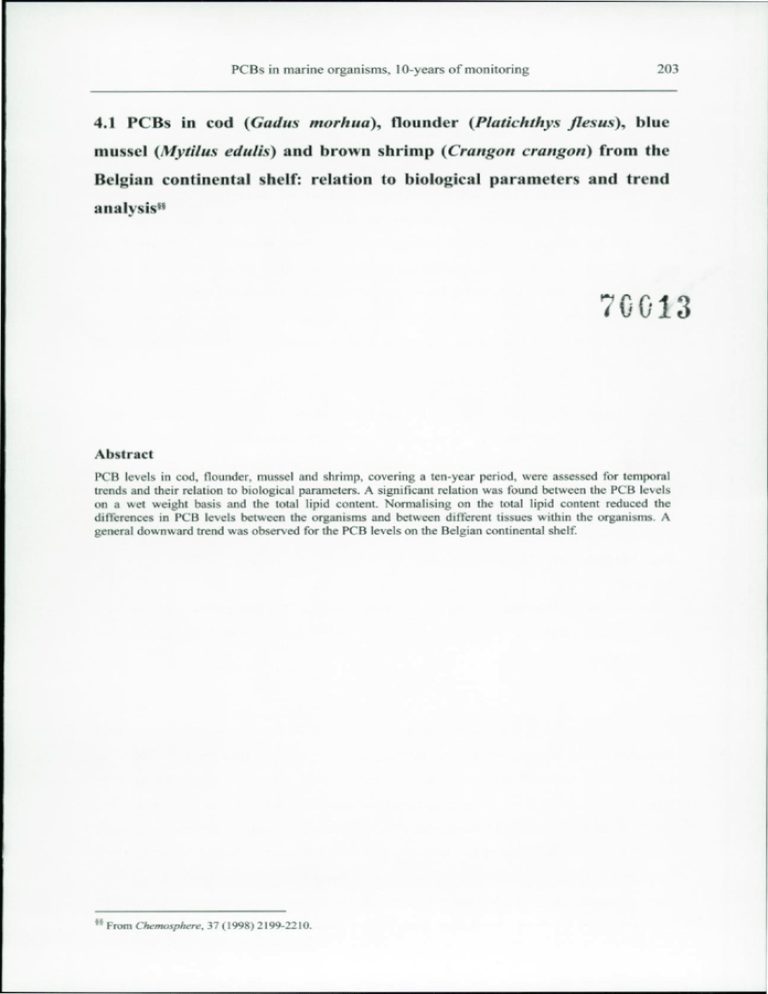
PCBs in marine organisms, 10-years of monitoring
203
4.1 PCBs in cod (Gadus morhua), flounder (Platichthys flesus), blue
mussel (Mytilus edulis) and brown shrimp (Crangon crangon) from the
Belgian continental shelf: relation to biological parameters and trend
analysis"
76013
Abstract
PCB levels in cod, flounder, mussel and shrimp, covering a ten-year period, were assessed for temporal
trends and their relation to biological parameters. A significant relation was found between the PCB levels
on a wet weight basis and the total lipid content. Normalising on the total lipid content reduced the
differences in PCB levels between the organisms and between different tissues within the organisms. A
general downward trend was observed for the PCB levels on the Belgian continental shelf.
44 From Chemosphere, 37 (1998) 2199-2210.
204
Compliance monitoring
4.1.1 Introduction
Polychlorinated biphenyls (PCBs) are ubiquitous environmental contaminants, which
have caused world-wide concern since the discovery of their presence in the environment
by Jensen [1]. Their widespread occurrence in the marine environment and their toxic
potential resulted in a number of international monitoring programmes such as the Coordinated Monitoring Programme of the International Council for the Exploration of the
Seas (ICES) and the Joint Monito ri ng Programme (JMP) of the Oslo and Paris
Commissions (OSPARCOM) [2]. These programmes aimed to assess the levels of PCB
contamination in the marine environment with an emphasis on human consumption and
the overall quality of the marine ecosystem, and to investigate possible trends in PCB
levels.
The Belgian Fisheries Research Station has been measuring PCBs in marine samples
since 1978. The data presented here cover an eleven-year period (1983-1993) and form a
solid basis to investigate time trends. Trends in the PCB concentrations in cod, flounder,
mussel and shrimp on the Belgian continental shelf in relation to biological parameters
such as fat content, age, weight, length and sex are assessed.
4.1.2 Materials and Methods
Materials
All materials used for this work were of research grade quality. Standard solutions were
prepared on a weight basis from pure compounds (> 99% pure) or certified reference
standards.
Sampling
Cod (Gadus morhua), flounder (Platichthys flesus) and shrimp (Crangon crangon) were
collected by the institute, using beam trawling, on the Belgian continental shelf from 1983
to 1993. Twenty-five individuals per fish species were sampled 2-3 months prior to
spawning and divided in five length classes between 214 and 905 mm for cod and 200
and 450 mm for flounder. Muscle tissue was analysed individually but livers were pooled
per length class. Shrimp sample sizes comprised 100 individuals. Cooked tail muscle was
isolated and divided in five subsamples. Mussels (Mytilus edulis) were harvested on three
jetties along the Belgian coast and sorted per length class of 20-30 mm, 30-40 mm, 40-50
mm and > 50 mm. Total sample sizes were between 150 and 617 individuals. The mussels
PCBs in marine organisms, 10-years of monitoring
205
were left in settled seawater at room temperature for 24 hours. Subsequently the soft body
was isolated for analysis. All samples were stored at -28 °C prior to analysis.
Chemical analysis
Extraction was based on total lipid extraction according to the method of Bligh and Dyer
[3]. The extracted lipids firstly used for the determination of the fat content were
redissolved in hexane, and the resulting solution was subsequently cleaned on a Florisil
column [4,5]. Analyses were performed on a Carlo Erba 4160 gas chromatograph
equipped with an electron capture detector and a 25 m SE-54 column (before 1990) or
(from 1990 onwards) a 60 m DB-17 and a 60 m DB-5 column (internal diameter 0.25
mm, film thickness 0.25 µm). Prior to 1989, the PCB concentrations were calculated on
the basis of comparison with eight PCB peaks of Aroclor 1260 [4]. These eight peaks
corresponded with IUPAC nos. 101, 136, 147, 153, 138, 128, 180 and 170 [6].
Concentrations of individual congeners, viz. IUPAC nos. 28, 31, 52, 101, 105, 118, 138,
153, 156 and 180 [6], are determined since 1989 [5]. Prior to 1990, quality assurance
consisted of the analysis of procedural blanks, reproducibility and repeatability tests,
injection of standard solutions as unknowns, and analysis of samples with known
concentrations. Since 1990, the analysis of a certified reference material (BCR CRM 349)
has been added as a standard procedure.
Conversion of data calculated with the Aroclor standard.
Due to the lack of individual PCB congener concentrations, before 1989, all statistical
analyses had to be performed on the total PCB concentrations. Since 1989 individual
congener concentrations are calculated and summed to express the total PCB
concentration (EPCB). However, the resulting sum is not equal to the concentration
calculated on the basis of Aroclor 1260 (Aroclor concentration). A conversion or
recalculation method was therefore developed. The conversion is based on the fact that
the ratio between the total PCB concentrations calculated with both methods should
remain constant if the PCB patterns are identical and the ratios of the individual peaks to
the total peak pattern are constant. A conversion factor (CF) can then be calculated, which
is given in Equation 1.
(1)
CF = [Aroclor]
E PCB
Compliance monitoring
206
with [Aroclor] = concentration based on Aroclor 1260 and EPCB = summed
concentration of individual PCBs
Consequently the older Aroclor concentration can now be recalculated to give EPCB
values. All EPCB referred to in this paper are either the sums of individual congeners or
the concentrations recalculated as described above.
10
9
8
=
7
Max
Min
75%
25%
6
— Median
~
W
5
4
3
2
Shrimp
Mussel
Cod
Flounder
Figure 4.1.1: Ratio between EPCB and CB 153 for shrimp, mussel, cod and flounder in
the period 1990-1993.
Statistical analysis
All statistical analyses were performed on EPCB and the level of significance was set at
95%. Correlations between fat content, length of the animal and PCBs were analysed by
linear regression. The non-parametric Mann-Withney test was used to investigate the
relation between sex and PCB concentrations, and the non-parametric Kruskall-Wallis
ANOVA test combined with Dunns' post test was performed to compare the PCB
contents of liver and muscle tissues in and among species and to study the influence of
the age of the animals on the PCB content. Time-trend analysis of the PCB concentrations
(median values per year) in cod, flounder and mussel were studied according to the
method of Nicholson et al. [7]. PCB trends in shrimp were analysed by linear regression.
PCBs in marine organisms, 10-years of monitoring
207
4.1.3 Results
Recalculation of the Aroclor concentrations
Converting the Aroclor concentrations to EPCB by using Equation 1 requires that the
PCB pattern of a given species/tissue is identical and that the ratios of the concentration
of individual peaks to the total peak pattern are constant. The ratios between EPCB and
CB 153 were calculated for the data obtained since 1990 and are presented by box and
whisker plots in Figure 4.1.1. The results show a narrow box for cod, flounder and blue
mussel and prove that the ratio remained constant; they also allow to suggest that the PCB
patterns are similar. However, the shrimp data show a different pattern, which may find
its origin in the rather small data set available. The PCB concentrations in the samples of
cod and flounder, taken in 1991, and of mussel and shrimp, taken in 1991-1992, were
then calculated using both methods of calculation and for each sample the CF was
calculated according to Equation 1 (Table 4.1.1). Next, the Aroclor concentrations were
re-calculated into EPCB.
Table 4.1.1: Conversion factors (CF) for the recalculation of `Aroclor'
data.
Species
CF
Cod
4.20 ± 0.04 (n=25)
Flounder
3.6 ± 0.1 (n=25)
Mussel
3.4 ± 0.1 (n=12)
Shrimp
3.1 ± 0.1 (n=10)
In principle, the CF value of 3.1 cannot be used to recalculate the Aroclor concentrations
of shrimp, since the experimental results do not provide the required proof. However, the
standard deviation of the CF is rather small; it is, moreover, similar to that of the other
species. Moreover, a similarity between PCB patterns in invertebrates has been reported
in the literature [8,9] and is indeed found for mussel (cf. above). We therefore assumed
that the PCB patterns in the same species of invertebrate from the same location will be
essentially the same and used the CF-based procedure also to recalculate the older data
for shrimp.
208
Compliance monitoring
Relation between PCB concentrations and total lipid content.
The results of the correlation analysis between the total lipid content and log (EPCB) for
the different species and tissues are given in Table 4.1.2. A significant correlation
(p<0.05) was found for the log (EPCB) expressed on a wet weight basis and the total lipid
content, despite the large variability of the data (Figure 4.1.2). No significant correlation
was found when the concentrations were normalised on the total lipid content (Table
4.1.2).
Flounder: muscle
Flounder: muscle
0
2
.
.
.
• •.
• •~..
•
r d ti
"MI
. •
• •
• ~
7
•
-3
~
0
1
2
3
Total lipid content (%)
4
0
1
2
3
4
Total lipid content (%)
Figure 4.1.2: Relationship between total lipid content and log (EPCB) expressed on wet and fat weight
basis (r, correlation coefficient; dotted line, 95% confidence interval of the mean).
The effect of lipid normalisation of the PCB data is illustrated in Figure 4.1.3 for all
species and tissues examined. The results of a Kruskal-Wallis ANOVA analysis of the
data indicate significant (p<0.05) inter-tissue and inter-species differences. However,
narrowing this down with Dunn's post test revealed that the differences between cod
liver, flounder liver, flounder muscle and blue mussel (soft body tissue) were not
significant. Obviously, normalisation on the total lipid content reduces the differences in
PCB levels between the organisms and between different tissues within the organisms,
that is, the results illustrate the impo rtance of lipids as a normalising factor. PCB
concentrations are therefore only considered on a fat weight basis in the remainder of this
paper.
PCBs in marine organisms, 10-years of monitoring
209
Table 4.1.2: Results of correlation analysis between total lipid content and log (EPCB) on
wet and fat weight basis for the different species and tissues.
Parameter
Total lipid content (%) vs. log
Total lipid content (%) vs. log
(EPCB) on wet weight basis
(EPCB) on fat weight basis
r
p
0.25
<0.05
0.7255
0.42
<0.05
0.1392
Blue mussel
0.50
<0.05
0.7526
Brown shrimp
0.51
<0.05
0.7685
Cod muscle
r
p
Cod liver
Flounder muscle
Flounder liver
p = p value, r = correlation coefficient
A
~
B
® Cod: muscle
® Cod: her
fille Flounder: muscle
t;• Flounder: liver
E~ Mussel: soft body
[Trill Shrimp: tail muscle
~
c
0.0
v
0
Species and tissue
muscle
® Cod: her
® Flounder: muscle
Flounder: aver
Mussel: soft body
=Shrimp: tail muscle
t,
w
w
® Cod:
I1 3
= rriTirl
Species and tissues
Figure 4.1.3: PCB concentrations for cod, flounder, mussel and shrimp, (A) not normalised and (B)
normalised on total lipid content.
Relations between EPCB and length and sex
The trend analysis of Nicholson et al. [7] dictates a different approach when a length
effect has been established. As regards both fish species, no demonstrable size effects
were found except in cod liver (Figure 4.1.4). The EPCB concentrations were in addition
to body size also related to sex, but no significant relations were found.
As a result of the sampling procedure, no individual size data were available for the
invertebrates. For mussel, however, samples were divided into five length classes and the
EPCB concentrations were compared. The results are shown in Figure 4.1.5. The length
class has, apparently, no effect on the EPCB concentrations, which was confirmed with a
Kruskal-Wallis ANOVA test.
Compliance monitoring
210
Cod: liver
Flounder: muscle
C
5
r=0.36
• r
:
•
'
,
••~.
•• t e•~~
•
•,s •{~
~• ~•
,• ~ ' •
:~
t.
•i
~
200
•
•~,•
•. * ..
•
.~ ~~ •}
•r
••~yr`•~Y~- . r
300
400
•
o
500
250
0
500
750
1000
Median of the length in mm
Length in mm
Figure 4.1.4: Relationship between length and log (EPCB) expressed on fat weight basis for flounder
muscle tissue (left) and cod liver (right) (line illustrates calculated significant trends; r, correlation
coefficient; dotted line, 95% confidence interval of the mean).
Mussel
20-30
30-40
40-50
>50
Length class (mm)
Figure 4.1.5: Relationship between length class and log (EPCB)
expressed on a fat weight basis for blue mussel (box, median and 25
and 75 percentiles; whiskers, minimum and maximum).
Temporal-trend analysis
The observed absence of relations between the PCB content and the animals' length or
sex allowed the analysis of temporal trends in cod muscle, flounder muscle and flounder
liver tissues and in blue mussel without statistical modifications, but not for cod liver with
which a length effect was found, nor for brown shrimp for which the length effect was not
studied. As regards the cod liver data, they were subdivided at the median into a `small'
and a `large' group and both were analysed independently [7]. Temporal trends in brown
shrimp data were analysed by linear regression. The data were log transformed in order to
PCBs in marine organisms, 10-years of monitoring
211
approach the normal distribution. The temporal trends are illustrated in Figure 4.1.6 and
the lipid normalised mean and median concentrations are given in Table 4.1.3. Longterm changes in the PCB concentrations were only considered as significant within a 95%
confidence inte rval. The results revealed (1) significant year-to-year differences in cod
and flounder muscle tissues and flounder liver tissue, (2) a significant downward nonlinear trend in cod muscle, (3) a significant downward linear trend in flounder muscle, (4)
no trend in blue mussel tissue, (5) a significant downward trend in brown shrimp and (6)
no significant trends in cod and flounder liver tissues.
4.1.4 Discussion
For the four species studied the PCB concentrations expressed on a wet weight basis
show a significant correlation with the fat content. This finding agrees well with previous
observations. Schaefer et al. [ 10] demonstrated that PCB concentrations per wet weight in
different tissues of cod rose with increasing lipid content as did Schneider [11]. Goerke et
al. [12] found positive correlations between PCB concentrations and the fat content of
various marine organisms. Positive correlations between PCB concentrations on a d ry
weight basis and the lipid content of various ma rine organisms were also reported by
Delbeke et al. [ 13].
Moreover, inter-species and tissue-type differences decreased when PCB concentrations
were normalised for the fat content. The correlation between fat content and log (EPCB)
illustrates the need for a normalisation of the PCB concentrations on a fat basis, especially
when a time-trend assessment is attempted. The explanation probably is that the natural
variations in the lipid content of an organism or organ, due to e.g. spawning or lack of
food, may influence the variability of contaminant data when these data are expressed on
a fresh (wet) weight basis. Delbeke et al. [ 13] observed a similar reduction of the interspecies variability of PCB isomer concentrations after normalisation of the data on `total
neutral lipids', as determined by Iatroscan analysis. Using this selected class of lipids for
normalisation proved superior to using the total lipid content (gravimetrically
determined). The authors concluded that this kind of normalisation may provide a basis
for extrapolation of PCB pollution data among species. However, the inter-tissue and
inter-species variability of our contaminant data is on the same order of magnitude as that
Compliance monitoring
212
observed by Delbeke et al. [ 13]. Consequently, there may be some doubt whether
speciation of the lipids would give an improvement in this case.
Cod: muscle
Cod: liver
5
0= -0.14
t
T
~
83 84 85 86 87 88 89 90 91 92 93
0 83 84 85 86 87 88 89 90 91 92 93
Year
Year
Flounder: muscle
15
Flounder: liver
C
C
10.0
o
r= -0.27
s
7.5
70
ci 5.0
Z
u
2.5
Û
a
w
83 84 85 86 87 88 89 90 91 92 93
0.0 83 84 85 86 87 88 89 90 91 92 93
Year
Year
Shrimp
Mussel: soft body
0.5
.
03
C1
2. 0.0-
~~m",,
Nlissuir
~
T
1
g -1.01.5
0 83 84 85 86 87 88 89 90 91 92 93
Year
r=
1
-
1
0.725
1
1
1
1
1
1
1
1
I
82 83 84 85 86 87 88 89 90 91 92 93 94
Year
Figure 4.1.6: EPCB concentrations in µg/g fat weight for cod, flounder and mussel (lines illustrate calculated
significant trends; r , correlation coefficient; boxes, median and 25 and 75 percentiles; whiskers, minimum and
maximum) and linear trend for the log(EPCB) concentration in shrimp (r, correlation coefficient; dotted line,
95% of the mean).
213
PCBs in marine organisms, 10-years of monitoring
Table 4.1.3: Mean and median concentration (ug/g fat weight), standard deviation (s) and number of
samples (n) for the different species in the period 1983-1992.
87
88
84
85
86
83
89
90
91
92
93
2.1
25
0.9
2.1
1.3
25
0.9
1.2
0.44
25
0.31
0.33
0.57
25
0.54
0.38
0.43
25
0.15
0.40
1.2
5
0.2
1.1
2.7
5
0.9
2.9
Cod muscle tissue
Average
n
Median
0.87
25
0.34
0.81
1.8
18
0.5
1.9
0.84
25
0.29
0.77
1.2
25
0.5
1.0
0.64
25
0.28
0.58
0.33
25
0.23
0.26
2.0
5
0.5
2.2
3.2
5
0.9
2.9
2.5
5
0.7
2.1
2.5
5
0.4
2.5
1.7
5
0.6
1.4
0.64
5
0.14
0.69
3.4
25
0.8
3.3
3.1
20
1.7
2.4
3.1
25
1.8
2.4
3.2
25
1.2
2.9
2.5
25
1.1
2.0
1.9
25
1.2
1.7
3.8
25
2.4
3.1
3.3
25
2.7
2.1
1.8
20
0.7
1.8
2.5
25
1.8
2.0
1.7
25
2.0
0.9
4.9
5
1.8
5.8
3.3
5
1.6
2.3
4.4
5
0.8
4.4
3.6
5
0.45
3.9
3.3
5
1.2
2.8
2.5
5
1.3
2.0
4.6
5
1.9
4.8
4.9
5
2.6
3.9
1.7
4
0.5
1.7
2.8
5
0.6
2.7
1.8
4
0.6
2.0
2.5
4
0.3
2.4
2.3
4
0.2
2.3
1.90
4
0.03
1.91
2.3
4
0.4
2.2
0.85
4
0.04
0.84
3.7
4
0.5
3.6
1.7
4
0.1
1.6
1.6
4
0.2
1.6
1.3
4
0.2
1.3
1.6
4
0.1
1.6
0.50
13
0.08
0.49
0.49
5
0.09
0.47
0.71
5
0.21
0.72
0.28
5
0.07
0.26
0.49
5
0.18
0.47
0.21
2
0.02
0.21
0.17
5
0.02
0.18
0.29
5
0.03
0.29
0.26
5
0.05
0.28
Cod liver
Average
n
Median
Flounder muscle tissue
Average
n
Median
Flounder liver
Average
n
Median
Blue mussel
Average
n
Median
Brown shrimp
Average
n
Median
0.35
5
0.06
0.33
Length and sex had no noticeable effects on the PCB concentrations expressed on a fat
weight basis, with one exception: PCB conce ntrations in cod liver significantly increased
with length. An influence of the length of cod on the PCB content in the liver was
previously reported by de Boer [ 14], who demonstrated a significant concentration
214
Compliance monitoring
difference between individuals of different sizes (53-54 cm and 85-91 cm). Similarly,
Kruse and Kruger [15] measured higher DDT levels in liver of Baltic cod of larger size,
but they did not notice similar trends for hexachlorobenzene
(HCB),
a-
hexachlorocyclohexane (a-HCH) or dieldrin. Bioaccumulation of contaminants such as
PCBs in biota is the result of a combination of uptake (directly from the water, ingestion
of contaminated particles and food) and elimination (metabolisation, excretion, growth
dilution, spawning). The relative importance of each process will, of course, depend on
the species considered and its stage of life. An explanation for the size-dependent
contaminant level in cod liver may be found in the regime of larger cod. Larger cod
mainly feeds on fish, which is more contaminated than invertebrates that are
preferentually consumed by smaller fish [ 16]. The major route of PCB uptake in larger
cod, food, will therefore cause biomagnification. The bioaccumulation in muscle tissue is,
however, not size-dependent; this may be related to the fact that lipid deposition with cod
is mainly in the liver. The food consumption pattern of flounder, mussel and shrimp does
not change during their life cycle [ 17]. For those species, no significant biomagnification
was found; obviously, the uptake of PCBs is compensated by elimination processes.
Significant downward trends were observed in muscle tissue of cod and flounder, and in
shrimp, but not in mussel and the liver of both fish species. From among these species,
flounder, blue mussel and brown shrimp are excellent indicator organisms which clearly
reflect the quality status of their habitats because of no or restricted migratory activities.
Cod has a more enhanced migratory behaviour and does not necessarily reflect the
condition of the area of capture. Nevertheless, cod is considered to be a suitable
biomonitor for spatial and temporal trend monitoring. Migration appears to be sufficiently
confined and allows observing differences between regions that are some hundred
kilometres apart [ 18]. The observed temporal trends in this study are on the same tenor as
others recently reported. In the 1993 No rth Sea Quality Status Repo rt [2], decreasing PCB
contents were cited for several species and various locations were cited and recent
observations revealed decreasing concentrations of lower-chlorinated PCBs in yellow eel
(Anguilla anguilla) from inland waters in the Netherlands [ 19]. PCB concentrations in
cod (Gadus morhua) from the No rth Sea have been shown to have decreased
significantly, although higher chlorinated congeners remained at an essentially constant
level [ 19]. Constant PCB contents were reported by Stronkhorst [20] for Mytilus edulis
and by Solé et al. [21] for Mytilus galloprovincialis from the western Mediterranean. The
PCBs in marine organisms, 10-years of monitoring
215
observed trends may well indicate that PCB concentrations have reached their maximum
values and that the compulsory remedial actions implemented by national and
intern ational organisations to improve the quality of the marine environment gradually
become successful. However, although PCB concentrations are shown to decrease
regionally, a global decline is not expected in the next few years, because of on-going
inputs into the environment caused by, e.g., leakages from landfills and emissions from
incinerators [22]. This was emphasised recently during the latest assessment of the
OSPAR coordinated environmental programme at the MON 2004 meeting [23].
Moreover, it has been stated that the quantities of PCBs still in use, still exceed the
amount that has been released into the environment to date [22]. A nice illustration is the
recent the `dioxin' crisis in Belgium where poultry were severely contaminated by PCBs
through an illegal addition of a PCB containing oil to oils used for the preparation of their
feed [24].
References
I.
2.
3.
4.
5.
6.
7.
8.
9.
10.
11.
12.
S. Jensen, Report of a new chemical hazard. New Scientist, 15 (1966) 612.
North Sea Task Force, North Sea Quality Status Repo rt 1993, Oslo and Paris Commissions, London,
UK, 1993.
E.G. Bligh and W.J. Dyer, A rapid method of total lipid extraction and purification for organic
compounds. Can. J. Biochem. Physiol. 37, 911-917 (1959).
K. Vandamme, and M. Baeteman, Teneur des organismes marins des eaux côtières belges en PCB et
en pesticides organochlorés. Revue de l'Agriculture 2, 1951-1958 (1982).
P.Roose, K. Cooreman, and W. Vyncke, Correlation between EROD and GSH-T activities and the
presence of organochlorines in the liver of dab from the Belgian continen tal shelf. International
Council for the Exploration of the Seas (ICES), Kopenhagen, Denmark, E:15, 14 pp (1993).
K. Ballschmiter, R. Bacher, A. Mennel, R. Fisher, U. Riehle and M. Swerev, The determination of
chlorinated biphenyls, chlorinated dibenzodioxins and chlorinated dibenzofurans by GC-MS. J. High
Resolut. Chromatogr. 15, 260-270 (1992).
M.D. Nicholson, R.J. Fryer and J.R. Larsen, Revised statistical analysis of JMG con taminant trend
monitoring data. International Council for the Exploration of the Seas (ICES), Kopenhagen,
Denmark, MON 11/3/1-E:3, 20 pp (1993).
J.P. Boon, M.B. Van Zantvoort and M.J.M.A. Govaert, Organochlorines in benthic polychaetes
(Nephtys spp.) and sediments from the southern No rth Sea. Identification of individual PCB
components, Neth. J. Sea Res. 19, 93-109 (1985).
R. Knickmeyer and H. Steinhart, Concentrations of organochlorine compounds in the hermit crab
Pagarus bernhardus from the German Bight, December 1988 — May 1989. Neth. J. Sea Res. 25, 365376 (1990).
R.G. Schaefer, W. Ernst, H. Goerke and G. Eder, Residues of chlorinated hydrocarbons in North Sea
animals in relation to biological parameters. Ber. Dt. Wiss. Komm. Meeresforsch. 24, 225-233
(1976).
R. Schneider, Polychlorinated biphenyls in cod tissues from the Western Baltic. Significance of
equilibrium partitioning and lipid composition in the bioaccumulation of lipophilic pollutants in gillbreathing animals. Meeresforsch. 29, 69-79 (1982).
H. Goerke, G. Eder, K. Weber and W. Ernst, Patterns of Organochlorine residues in animals of
different trophic levels from the Weser Estuary. Mar. Poll. Bull. 10, 127-133 (1979).
216
13.
14.
15.
16.
17.
18.
19.
20.
21.
22.
23.
24.
Compliance monitoring
K. Delbeke, T. Teklemariam, E. de la Cruz and P. Sorgeloos, Reducing variability in pollution data:
the use of lipid classes for normalisation of pollution data in marine biota. Int. J. Environ. Anal.
Chem. 52, 147-162 (1995).
J. De Boer, Spatial differences and temporal trends of bioaccumulating halogenated hydrocarbons in
livers of Atlantic cod (Gadus morhua) from the No rth Sea, 1977-1992, Proceedings of the Scientific
Symposium on the North Sea Quality Status Report 1993,110-114. North Sea Task Force, London,
UK (1996).
R. Kruse and K.E. Kruger, Organochlor-Pestizide in Dorshleber. Allg. Fischwirtschafsz. 33, 168-169
(1981).
N. Daan, Growth of North Sea cod. Neth. J. Sea Res. 6, 479-517 (1974).
F. Redant, Konsumptie en produktie van post larvale Cragnon cragnon (Crustacea, Decapoda) in de
Belgische kustwateren, Ph. D. Thesis, Free Universi ty of Brussels, Brussels, Belgium (1978).
J. De Boer and U.A.Th. Brinkman, The use of fish as biomonitors for the determination of
contamination of the aquatic environment by persistent organochlorine compounds. Trends in Anal.
Chem. 13, 397-404 (1994).
J. De Boer, Analysis and biomonitoring of complex mixtures of persistent halogenated
micro-contaminants, Ph.D. Thesis. Free University of Amsterdam, Amsterdam, the Netherlands
(1995).
J. Stronkhorst, Trends in pollutants in blue mussel Mytilus edulis and flounder Platichtys Jesus from
two Dutch estuaries, 1985-1990. Mar. Poll. Bull. 24, 250-258 (1992).
M. Sold, C. Porte, D. Pastor and J. Albaigés, Long-term trend of polychlorinated biphenyls and
organochlorinated pesticides in mussels from the western Mediterranean coast. Chemosphere 21,
1063-1085 (1994).
S. Tanabe, P.B.C. Problems in the future : Foresight from current knowledge. Environ. Poll. 50, 5-28
(1988).
OSPAR, 2005 CEMP report, Oslo and Pari s Commissions, London, UK, in preparation.
N. van Larebeke, L. Hens, P. Schepens, A. Covaci, J. Baeyens, K. Everaert, J. L. Bernheim, R.
Vlietinck, and G. De Poorter, The Belgian PCB and Dioxin Incident ofJanuary—June 1999: Exposure
Data and Potential Impact on Health, Environ. Health Perspec., 109, 265-273 (2001).
-
